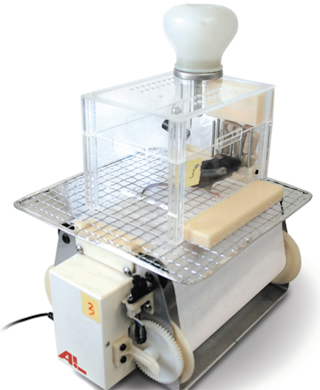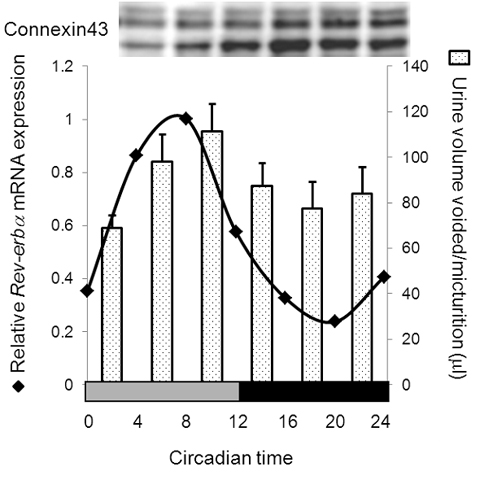May 2, 2012
Normal humans can store more urine in urinary bladder when asleep than when awake, to avoid the sleep getting disturbed by urination. A research group* has discovered that the circadian clock in the bladder supports this mechanism. This finding may give a clue to cure diseases with disturbed urination rhythm, like nocturnal enuresis or nocturia.
*Core members of the investigation team
Department of Urology, Graduate School of Medicine: Professor Osamu Ogawa, Dr Akihiro Kanematsu**, Dr Hiromitsu Negoro***
Field of System Biology, Graduate School of Pharmacology: Professor Hitoshi Okamura
Field of Biomaterials, Institute for Frontier Medical Sciences: Professor Yasuhiko Tabata
**: presently Hyogo College of Medicine, ***: presently Albert Einstein College of Medicine, NY
Summary
Mammalians cells have the circadian clock, genetic machinery that has 24 hour rhythmicity. It is believed that the circadian clock in many peripheral organs generate their own rhythms, which are integrated by central clock in the brain. Each peripheral circadian clock is believed to play important roles for organ function, although it is not elucidated in the urinary bladder at all.
Normal humans urinate infrequently during sleep, because kidneys produce less urine and bladder can store more urine than when awake. The disturbance in these rhythms results in nocturnal enuresis in children, or nocturia in elderly, two very prevalent conditions. We demonstrated that the circadian clock tunes the bladder to change its capacity to hold urine during the 24 hour cycle, using mice and rats.

The recording of mouse urination has been challenging because voided urine volume is minute. We devised a machine, which winds up rolled filter paper in a constant speed. Urine stains on the paper could be converted to urine volume, so that it can record when and how much amount of urine was voided by the mouse. This system was named aVSOP (automated voided stain on paper) method. The aVSOP method could accurately record mouse urination pattern and revealed that mice urinate less frequently and store more urine during sleep than when awake.
Clock genes, the molecular components of the circadian clock, were found to show rhythmic oscillations in the bladder. These rhythms were maintained in the bladder kept ex vivo in culture dish, unaffected by systemic awake/sleep status. On the other hand, mice having no functional circadian clock (cry-cull mice) showed, by aVSOP analysis, no diurnal variation in voided volume per urination and urination frequency. This meant that the circadian clock controls urination rhythm.
Connexin43 (Cx43) is a molecule that constitutes gap junctions, which are pores that connect cells to adjacent cells, permitting various stimuli to be propagated. This indicates that when the amount of Cx43 is low, the propagation of stimuli between the cells is low. The mice depleted with Cx43 gene showed more voided volume per urination than did normal mice.
Moreover, Cx43 gene product showed 24 hour rhythm, which increased during active phase and decreased during sleep phase in rats and mice. Muscle cells retrieved from the rat bladder also had the circadian clock rhythm, and showed oscillations of protein amount of Cx43 and transmission rate between the cells. These mean that expression of Cx43 is likely to be controlled by the circadian clock in the bladder muscle cells.

Upper:Stains of the urine from normal mice by aVSOP method, Lower:Those from mice depleted with Cx43gene
We found that a gene called Rev-erbα, one of the clock genes, was involved in controlling Cx43 rhythm in the bladder. The Rev-erbα has been known to bind directly to DNA of the target genes, and decrease proteins to be produced from DNA. However, for Cx43 gene, Rev-erbα binds indirectly to DNA, by binding to another DNA-binding molecule Sp-1, and increased protein production of Cx43. This mechanism has not been known with clock genes.

Conclusion
We have proved the involvement of the clock genes for formulation of diurnal micturition rhythm. This suggests that the circadian clock could be a key for investigating the treatment of nocturnal enuresis or nocturia.
Related link
- The paper is on the following website:
http://dx.doi.org/10.1038/ncomms1812 - Bibliographic information is as follows:
Negoro Hiromitsu, Kanematsu Akihiro, Doi Masao, Suadicani Sylvia O., Matsuo Masahiro, Imamura Masaaki, Okinami Takeshi, Nishikawa Nobuyuki, Oura Tomonori, Matsui Shigeyuki, Seo Kazuyuki, Tainaka Motomi, Urabe Shoichi, Kiyokage Emi, Todo Takeshi, Okamura Hitoshi, Tabata Yasuhiko, Ogawa Osamu.
Involvement of urinary bladder Connexin43 and the circadian clock in coordination of diurnal micturition rhythm. Nature Communications.
2012/05/01/online.
doi: 10.1038/ncomms1812

